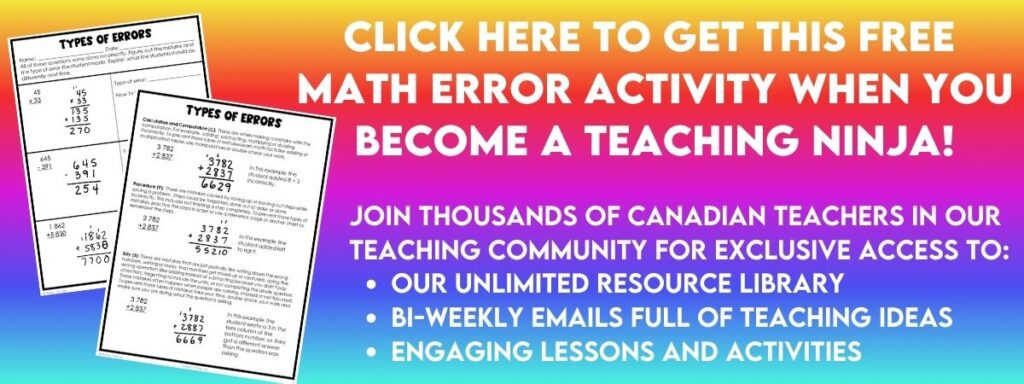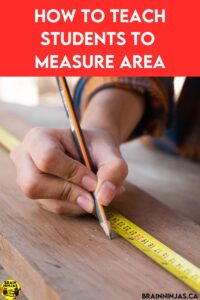
The biggest mistake students often make when they measure area is that they aren’t quite sure what they are supposed to be measuring. Generally, the area is the amount of space inside a two-dimensional shape. We try to teach students math using plenty of hands-on activities. Come read about the ways we measure area in our upper elementary math class.
Introduce a Measuring Area Activity
Hand out a piece of graph paper and ask students to draw a shape that traces the lines on the page (meaning no diagonal lines). If you are looking for a free place to download some graph paper, we use this site. Don’t use the word area or explain what students will be doing quite yet.
Have students exchange their graph paper with a classmate. The classmate will count the number of squares inside the shape and write the number inside the shape.
Explain that students will use the word “units” as the measurement unit for this activity. Since we are measuring with squares, it will be units squared. This is written as u². So, if there are 14 squares inside the shape, it would be written as 14u². Explain that when students measure the squares, it’s important to include the u² so others will know what has been measured.
Repeat the activity a few times, having students exchange with a different person each time. If the shapes are big, use a different coloured marker for each shape and let them overlap.
You can also mix this up by giving students a measurement and then having them try to draw a shape that matches.
Explain Area
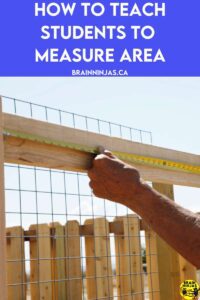
Explain to students that area is the measurement of the space enclosed by a two-dimensional shape, such as a rectangle, square, or triangle. Area is the inside (and if your students have already learned about perimeter, make the comparison).
Introduce students to common metric units of area measurement, such as square centimetres (cm²), square metres (m²), and square kilometres (km²).
Explain that if students are comparing two different shapes and their areas, they should use the same unit of measurement so that the comparison is accurate.
Teaching Strategies for Measuring Area
Explicity Teach How to Measure Area
We use interactive notebooks to make a reference page that students can use as they learn to master the measurement of area. Our notebooks include all the lessons needed for teachers, options to modify, student pages, templates, practice pages, games, activities, and assessments. They’ve been written to align with math outcomes for British Columbia, Alberta, and Saskatchewan but will work for most Canadian classrooms.
- Time and Measurement for Grade 3 in our TpT Store ($USD) or BN Shop ($CAN).
- Measurement for Grade 4 in our TpT Store ($USD) or BN Shop ($CAN).
- Measurement for Grade 4/5 in our TpT Store ($USD) or BN Shop ($CAN). This is designed for combined grade classes.
- Measurement for Grade 5 in our TpT Store ($USD) or BN Shop ($CAN).
- Measurement for Grade 5/6 in our TpT Store ($USD) or BN Shop ($CAN). This is designed for combined grade classes.
- Measurement for Grade 6 in our TpT Store ($USD) or BN Shop ($CAN).
Using Worksheets and Task Cards
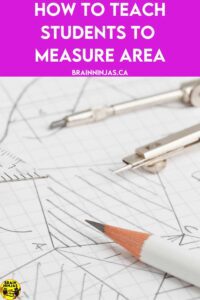
We recommend using the hands-on activities below, but they can be used along with worksheets and task cards. To keep it simple, we’ve listed them here.
Each of our worksheet sets includes fifteen pages of varying levels. We try to make our worksheets clear of distractions and large enough for students to show their work on the page. If you’re looking for more ways to use a worksheet, read Math Worksheet Games Your Students Will Love.
Area of Polygons Without Formulas in our TpT Store ($USD) or BN Shop ($CAN).
Area With Tiles/Grids in our TpT Store ($USD) or BN Shop ($CAN). Students do not need any manipulatives to use these.
Area of Rectangles in our TpT Store ($USD) or BN Shop ($CAN).
These sets are recommended for grades 5 or older.
Area of Triangles in our TpT Store ($USD) or BN Shop ($CAN).
Area of Parallelograms in our TpT Store ($USD) or BN Shop ($CAN). Students do not need to use a specific formula.
Area of Trapezoids in our TpT Store ($USD) or BN Shop ($CAN). Students do not need to use a specific formula.
Area of Rectangles with Formulas in our TpT Store ($USD) or BN Shop ($CAN).
Our task cards come with three different decks, making it easy to differentiate for your students. If you aren’t sure about using task cards, take a look at the post The Trouble With Task Cards and How to Fix It.
Area of Polygons Task Cards for Grades 4-6 in our TpT Store ($USD) or BN Shop ($CAN).
Use Manipulatives to Measure Area
Tiling

Provide students with square tiles or grid paper and challenge them to cover various shapes with tiles. Have students count the number of tiles used to cover each shape and calculate the total area by multiplying the length and width of the shape.
Pattern Blocks
Use pattern blocks to create shapes on a grid or tabletop. Have students explore different arrangements of pattern blocks and calculate the area of each shape by counting the number of unit blocks used.
Geoboards
Provide students with geoboards and rubber bands to create shapes. Challenge students to calculate the area of each shape by counting the number of squares enclosed by the rubber bands.
Area Scavenger Hunt
Organize a scavenger hunt where students search for objects of different shapes and sizes around the classroom or school. Have students measure and calculate the area of each object using tiling, grids, or formulas.
Shape Building
Use tangrams or other shape-building materials and challenge students to create shapes with specific areas. Encourage students to experiment with different arrangements of shapes to achieve the area measurement.
Measure the Area of the Classroom or a Room You Design
Use rulers or measuring tapes to calculate the area of the classroom or any room.
Use a piece of graph paper to design a room. Measure the area of the whole room or different elements in the room.
Formulas
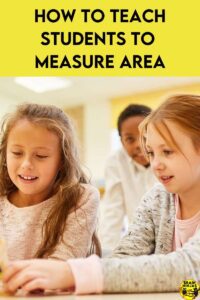
We typically stick to concrete ways to measure area when first starting, but rectangles are a great way to introduce formulas. The formula we teach is area = length x width.
Once students have mastered the formula for rectangles, teaching the formula for triangles makes more sense. The formula we teach is area = 1/2 (length x width).
Next, we teach the formula for parallelograms. The formula we teach is area = bh (area = base x height).
Make an anchor chart with the formulas and examples to use as a reference point. Part of the route to mastery is repetition, but that’s only helpful if the repetition is correct.
Make Mistakes
One of the best ways to see how well your students understand area is by giving them an equation with a wrong answer or making a mistake while calculating area. They’ll call you out right away.
We teach students how to figure out why they’ve made a mistake through error analysis. You can read this whole post to learn more: How to Teach Students to Analyze Errors in Math.
We’ll send this free error analysis lesson when you sign up for our email list. If you’re already on this list, you can find it in our Resource Library.
Measure Area All Year
You might teach the measurement of area during a specific unit but review it throughout the year. Measure area each day with something small and quick. Use the measurement in other subject areas so students can see how it is used in daily life.
Do You Teach Math in Canada?
These blog posts might be able to help you with your math instruction.
- Plotting on the Cartesian Plane During Math Class
- Ways to Teach Classifying Triangles
- How to Teach Rounding Numbers
- How to Demystify Math With These 7 Algebra Activities
- 7 Ways to Upgrade Your Fraction Strategies
We’d love to hear some of the ways you teach students to measure area in your classroom.

